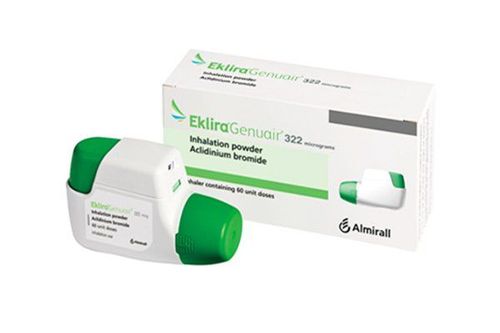This is an automatically translated article.
Aclidinium belongs to the class of anticholinergic drugs indicated for the long-term management of chronic obstructive pulmonary disease (COPD). The drug works by virtue of a higher propensity to bind to muscarinic receptors than to nicotinic receptors. However, when using Aclidinium, there may be some side effects related to breathing problems. Therefore, before using the drug, the patient should carefully study the information of the drug and consult the treating doctor.
1. Mechanism of action of the drug Aclidinium
What is aclidinium? Aclidinium belongs to the class of anticholinergic drugs with prolonged or competitive or reversible action and specific drug for muscarinic acetylcholine receptors. Aclidinium binds to all five muscarinic receptor subtypes with similar affinity.
Aclidinium will act on the airways mediated through M3 receptors in smooth muscles to cause bronchodilation. Thereby, helping to prevent the bronchodilator effect caused by acetylcholine compounds. However, this effect will depend on the dose used and the duration will last more than 24 hours.
Mechanism of action Aclidinium does not prolong the QTc interval or can significantly affect the patient's heart rate.
2. Dosage and how to use Aclidinium
Aclidinium is used for people with chronic obstructive pulmonary disease at a maintenance dose of 400mcg for one inhalation or 2 times daily.
For patients with chronic obstructive pulmonary disease accompanied by kidney disease and liver disease, they are still treated with the above dose.
For children, there are no clear studies on the use of Aclidinium in children. However, the case of children with disease should be examined and consulted by a doctor.
In case the patient accidentally takes Aclidinium in excess of the prescribed dose and has some signs such as shortness of breath, fainting, etc., it is necessary to take the patient to an emergency at the nearest medical facility for treatment. can provide timely support to help patients overcome dangerous situations.
If a patient takes Aclidinium and misses a dose, the missed dose can be used as soon as he remembers. However, if the interval between the missed dose and the next dose is close, the patient can skip the missed dose and take the next dose. Patients should also be careful not to use double the dose because it can cause drug overdose and unwanted side effects affecting the patient's condition.
3. Unexpected side effects when using the drug Aclidinium
The drug Aclidinium not only brings therapeutic effects to subjects with chronic obstructive pulmonary disease but also sometimes causes side effects during drug treatment. When experiencing side effects due to drug use, patients should immediately see a medical staff for timely care. Side effects when using Aclidinium may include:
Common side effects: fever, headache, muscle pain, sore throat, stuffy nose or may appear runny nose, fatigue, weakness. Less common side effects include: bladder pain, body aches, chest pain, bloody or cloudy urine, trouble with fast or pounding heartbeats, loss of voice , swollen lymph nodes in the neck... Rare side effects when using Aclidinium: chest discomfort, difficulty moving, varicose veins in the neck, increasing thirst, loss of consciousness, slow heartbeat, sweating, uncontrollable weight loss... Although serious side effects can be rare, if a person has any symptoms related to this condition, they should seek immediate medical attention. .
4. How to use drugs rationally
Aclidinium is made in inhaled form and is used to treat chronic obstructive pulmonary disease but is not used to relieve chronic obstructive pulmonary disease. Therefore, to relieve the onset of chronic obstructive pulmonary disease, the patient should use another drug. Furthermore, the drug should only be used as directed by the treating physician. Do not use more or use it more often than prescribed.
Besides, the patient should note that the drug should be used at the same time of day and also should not stop taking it without the permission of the doctor.
How to use your inhaler properly: Aclidinium comes in a sealed bag, so don't open the bag if it's not already in use. There is a green button on the medicine box to let the patient know that the medicine is ready for a dose. When using the inhaler, the patient should hold the tube toward himself and the green button held at the top. Next, press the blue button all the way down and release it. When performing this action, the inhaler should not be tilted. Before administering the drug, the patient should check the control window to ensure that the dose is always available. Also check if the blue control window changes from red to green.
If the window is still red, this should be done to ensure that the dose is ready for the next use. When inhaling the drug, the patient needs to perform a full exhalation and try to get as much air out of the lungs as possible.
The patient will place his lips tightly around the stethoscope and inhale quickly and deeply until a click is heard, but continue to inhale when he hears the clicking sound to ensure that the correct dose is provided to the patient. one inhalation. In inhaled gas, the patient must not hold the blue button, which may affect the drug delivery process. After inhaling the medicine, the patient takes out the inhaler and holds his breath until comfortable, then breathes slowly through the nose. Patients should not arbitrarily add doses if they do not feel any change after inhaling the medicine.
5. Notes when using the drug Aclidinium
Aclidinium can cause any allergic reaction in people with a history of allergy to its ingredients. In addition, there are inactive ingredients such as milk proteins that can cause allergic reactions or other problems when used. Therefore, you need to consult your doctor in detail before using.
For patients who are experiencing health-related problems such as a history of disease, glaucoma, difficulty urinating due to an enlarged prostate gland, etc., they should be careful when using Aclidinium. In cases of pregnancy, lactation, surgery, etc., there are still no adequate studies to determine the risks that Aclidinium may cause. But when using Aclidinium, these subjects need to be prescribed treatment from a doctor.
Drug interactions: Aclidinium may change how it works and may reduce or increase unwanted side effects. To avoid drug interactions when using Aclidinium, the patient should provide the pharmacist with a list of prescription drugs, or non-prescription drugs, and dietary supplements that the patient has used before. That can help the doctor prescribe the drug to use better. Besides, foods and alcohol also have certain effects with Aclidinium. Therefore, the use of these drugs should be limited during drug treatment.
Aclidinium drugs are stored at room temperature but need to be protected from moisture, light... can affect the drug's effectiveness. Moreover, patients should not store the medicine in the freezer compartment. And should use the drug exactly as prescribed by the doctor throughout the treatment.
Please dial HOTLINE for more information or register for an appointment HERE. Download MyVinmec app to make appointments faster and to manage your bookings easily.













